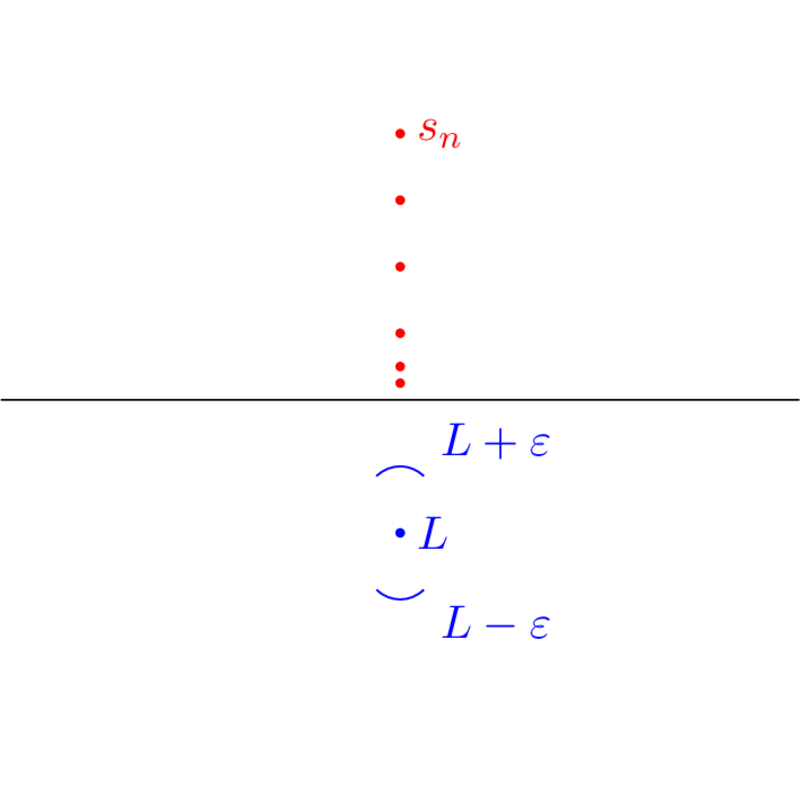Week 4 Discussion Notes
Table of Contents
Supremums and Infimums
Definition
Let be a non-empty set. If there exists such that for all , then we call the maximum of and we write .
Exercise 1.
Define .
At first glance, and look like the same thing. However, there's a key difference: has to be an element of , but doesn't have to be.
Example 1.
If , then has no maximum, but .
On the other hand, if , then .
Example 2.
(4.8) Let and be non-empty subsets of such that for all and .
- Observe that is bounded above and is bounded below.
- Prove .
Solution.
- Any element of is an upper bound of , and any element of is a lower bound of .
- If , then is an upper bound for , so by definition, . This means that is a lower bound for , so .
Density of in
Theorem
For any with , there exists a rational such that .
We know that has gaps in it, which is why we work with . However, the fact that is dense means that the gaps are very "tiny". In other words, no matter how far you zoom in, you'll always see infinitely many rational numbers.
Example 3.
(4.11) Consider where . Show that there are infinitely many rationals between and .
Solution.
(Hint) You can use induction with the following statement to prove this: "there are at least rationals in " for all . You could also do this by contradiction—either is fine.
Sequences
Definition
A sequence is a function , where we write and .
If there exists such that:
For all , there exists such that for all ,
we say that converges to and we write . Otherwise, if no such exists, then we say that is divergent.
Intuitively, the limit of a sequence is what it gets "really close to" as "gets really big". To make this more precise, we need to quantify two things:
- "really close to" (this is )
- "gets really big" (this is )
With this interpretation, you can read the definition like this:
If is large enough, we can make as small as we want.
The definition is (somewhat) intuitive, but using the definition to prove things is generally pretty tricky.
Example 4.
(Similar to 8.1(c)) Prove .
Solution.
When proving limits, we're given an (something out of your control), and we need to find (something you can control). The general strategy is to work backwards: start with
when . In the end, we want to make this quantity smaller than , so it's okay to look at bigger quantities. If we make the denominator smaller, then we get something bigger:
If we can make , then we're done. We're in good shape because we can:
None of what I wrote above is a proof (though it almost looks like one); it's just scratch work that I used to figure out what needs to be. Given an , our candidate for is , and it's now time to verify that this works. The following is the beginning of the proof of the limit:
Let . If we set , then if ,
was arbitrary, so what we wrote works for any , which completes the proof.
Example 5.
(Similar to 8.1(d)) Prove .
Solution.
We're going to apply the same strategy and work backwards: if , then
Like before, if we can make , then that gives us our candidate for :
So should work. We just need to prove that this works:
Let . If , then for , we get
To summarize, this is the basic strategy for proving limits through the definition:
- Work backwards and use inequalities figure out a candidate for .
- Generally, you want to make the numerator bigger (in absolute value) and/or the denominator smaller (in absolute value).
- Write out the proof with your candidate of .
- If you set it up right, then your proof will just look like what you wrote in step 1, but in reverse.
The definition can also be used to prove some useful facts about limits.
Proposition
Let be a sequence. Suppose for all and that exists. Then .
Proof.
Intuitively, it's obvious. However, proving it is a bit tricky since we need to use the definition of a limit. We'll do this by contradiction: assume for the sake of contradiction that . We then have the following picture:

The definition of a limit tells you that for any , eventually all the points in your sequence lie in the interval . From the picture, you should be able to see why that's impossible: if is small enough, then that implies that the sequence is eventually negative, which is a contradiction. Now we need to write that down:
If is too large, then we won't get a contradiction. Thus, we need to be smart about how we pick it. Based on the picture, if we let be half the distance from to , then we should be able to get a contradiction, i.e., let . By definition of the limit, there exists such that if , then . But this means
which is impossible, so to begin with.
Remark.
Notice that even though is strictly positive for all , its limit can still be equal to . For example, has limit even though all of its terms are .